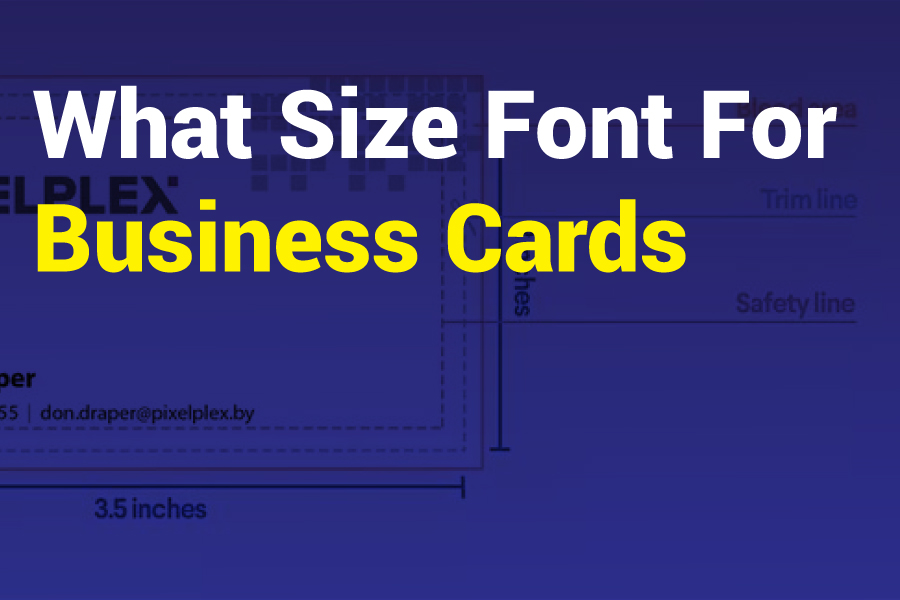What size font for business cards? Business cards are a physical representation of your identity and brand. If the font is too small, it becomes hard to read, while large fonts limit how much information you can include. Using different font sizes on a business card design is a usual norm to highlight vital details.
Fonts help convey your brand’s message and influence how people perceive and interact with your information. The font size on your business card is a vital aspect of its design. However, choosing the right font size for your business needs can take time and effort, with many options available.
Your business card fonts have two primary purposes: catching the clients’ attention and making the card easy to read. This article will discuss finding the perfect font size for your business card.
What size font for business cards?
The ideal font size for business cards is from 10 points to 16 points. However, aim for a size between 12 and 16 points for crucial details such as your brand’s name. Though this is a general guideline, specific factors, like your chosen size, will depend on your card’s design and dimensions.
Although it’s a general guideline, your size will depend on your card’s dimensions and design. Though this is a general guideline, specific factors, like your chosen size, will depend on your card’s design and dimensions. However, avoid using the smallest font size available for business cards.
The text size of your business card needs to be functional. Use a larger font size for main text, names, and headings to make vital details stand out and fill the space effectively. Choose a smaller font size for secondary text, such as contact information, but never go below 8 points. Anything smaller than 8 points can be hard to read and may negatively impact how clients view you and your business.
Why Font Size Matters on Business Cards?
Choosing the right font size for business cards is crucial for your design. The font size should be easy to read at a glance but not so large that it overwhelms the design. The right font size shows your attention to detail and professionalism. On the other hand, a poor size choice can make your brand seem less trustworthy.
Visually appealing business cards grab attention, and font size is crucial in their design. If the text is small on a business card, it can be challenging for recipients to read. This defeats the card’s purpose and could cause you to lose a valuable connection.
The Advantages of Using 10 Points Font Size on Business Cards
We typically use a 12-point font size for standard printed documents. Your reports, resumes, memos, and more are all expected to use a 12-point font size. But why do business cards need a smaller font size? This is because business cards are smaller.
A 10-point font size lets you share your information clearly with clients while keeping everything compact. Let’s examine the benefits of using 10-point font size on business cards.
Makes the Most of Your Card Space
Your business card must include many details, such as your company, name, title, and contact information. Remember that a standard business card is 85 millimeters x 55 millimeters, so space is limited.
That is why a 10-point font size works best. It’s smaller than average and lets you share all your details without taking up too much space. This way, your card won’t overwhelm recipients with too much text.
Simple to Read
When designing business cards, readability is crucial. So, you need a font size that is easy and clear to read. If the business card font size is too small, people might struggle to read it. A 10-point font size is perfect because it is smaller, clear, and readable.
When Should You Use Other Business Card Font Sizes?
The correct font size can strongly reflect your brand’s identity and make your business card easy to read. There isn’t a single perfect font size for all business cards.
Although a 10-point font size works well for most of your business card’s text, this regulation has some exceptions. For instance, you may need different sizes to make your card more engaging and visually appealing. Below are some font size guidelines for business cards to help you choose the best option.
For Name and Company Name
Your name and company name are the most crucial parts of your business card. So, make sure these elements are bigger than the rest of the text on your card. To ensure they stand out, set the font size for your job title, name, and company name to be at least one point bigger than the other text on the card.
However, be cautious to stay within 11 points, as larger text can make the card appear cluttered and difficult to read. If you want to include additional information on the back of your card, like your company logo and name, you have more flexibility with the font size.
Even so, it’s wise to keep the font size at no larger than 13 points. This helps prevent the text from becoming too wide and maintains the card’s clean, professional look.
For Contact Details
Contact details such as your email, business address, and phone number are usually the most minor components on your business card. This is because recipients who see your business card don’t always have to reach you right away; they do need to view your name and title first. Using the smallest possible font for these details is a good idea.
The standard font size for business cards is 10 points, but it’s a good idea to print your contact information in 8 or 9 points. Always ensure that no text on your business card is smaller than 8 points.
Anything smaller than that can be too hard for most recipients to read, and if your contact details are difficult to read, people might not reach out to you. Stick to an 8 or 9-point font size to free space while keeping your text clear and easy to read.
For Taglines
For taglines or social media handles, you need to use a font size of 6 to 8 points. Avoid overloading your card with too many details to keep it clean and uncluttered.
For Specialty Fonts
If you choose a special font for business cards, like a script-style font, 10 points might still be tiny to read clearly. In that case, you may need to use a slightly bigger font size, but ensure enough space to put all your information. Consider reconsidering your card’s design if you need a font size of 13 points or larger to make it readable.
Factors Influencing Business Cards Font Sizes
The font size is a crucial factor affecting your business card’s effectiveness. Here’s a list of things to consider when selecting the correct font size for your card:
Maintaining Branding Consistency
Keeping your brand’s fonts consistent is vital for brand recognition. If your brand already uses specific fonts, it’s best to use them on your business card to maintain visual identity. This might influence the business card font size you select to ensure consistency.
Font Style and Type
When choosing the text size for your business card, consider the font style and type. Sans-serif fonts such as Helvetica or Arial are easier to read in smaller sizes. This makes them a good choice for business cards.
Keeping Space for Visual Elements
Business cards usually feature visual elements like graphics, logos, or icons. These components can take up space and affect the amount of room you have for text. Make sure to balance visuals and text so that the font size on your business card is easy to read.
Card Layout and Size
The size of your business card affects how much space you have for the font size and text you can use. If you need to include a lot of details, you might have to use a larger-sized card or think about using a smaller font.
Making It Easy to Read
The primary purpose of a business card is to share important information about your business. That is why selecting a font size that is easy to read is crucial. If the text is too small and unreadable, it can frustrate people and make your card less effective. To avoid this, pick a font size that is readable and clear.
Audience Demographics
Think about your target audience when choosing the correct font size. A bigger font size is better for older people who might have trouble seeing small text. But if your audience is tech enthusiasts and younger, a smaller, more modern font might work well.
Emerging Trends
Design trends constantly evolve, and what looks stylish nowadays might be different in a few years. Remain updated with the latest industry trends to ensure your business card stays effective and relevant.
Information Hierarchy
Think about the order of information on a business card. You need to change the font size to highlight the most important details.
Printing Process
Different printing methods can impact the look of your font size. Talk to your business card manufacturer to see if the printing procedure you choose will impact readability.
Conclusion
What size font for business cards? The font you choose for your business card plays a big role in making your design readable and appealing. The main goal of making a business card is to leave a long-lasting impression. By now, you should have a good idea of how to pick the correct font size for your business card.
Hiring professionals is a good idea if you’re still hesitant or unsure about going the DIY route. Seek out professionals with experience creating business cards. You might be surprised by the value they can add. They can also help you choose the correct font size for effective marketing.



